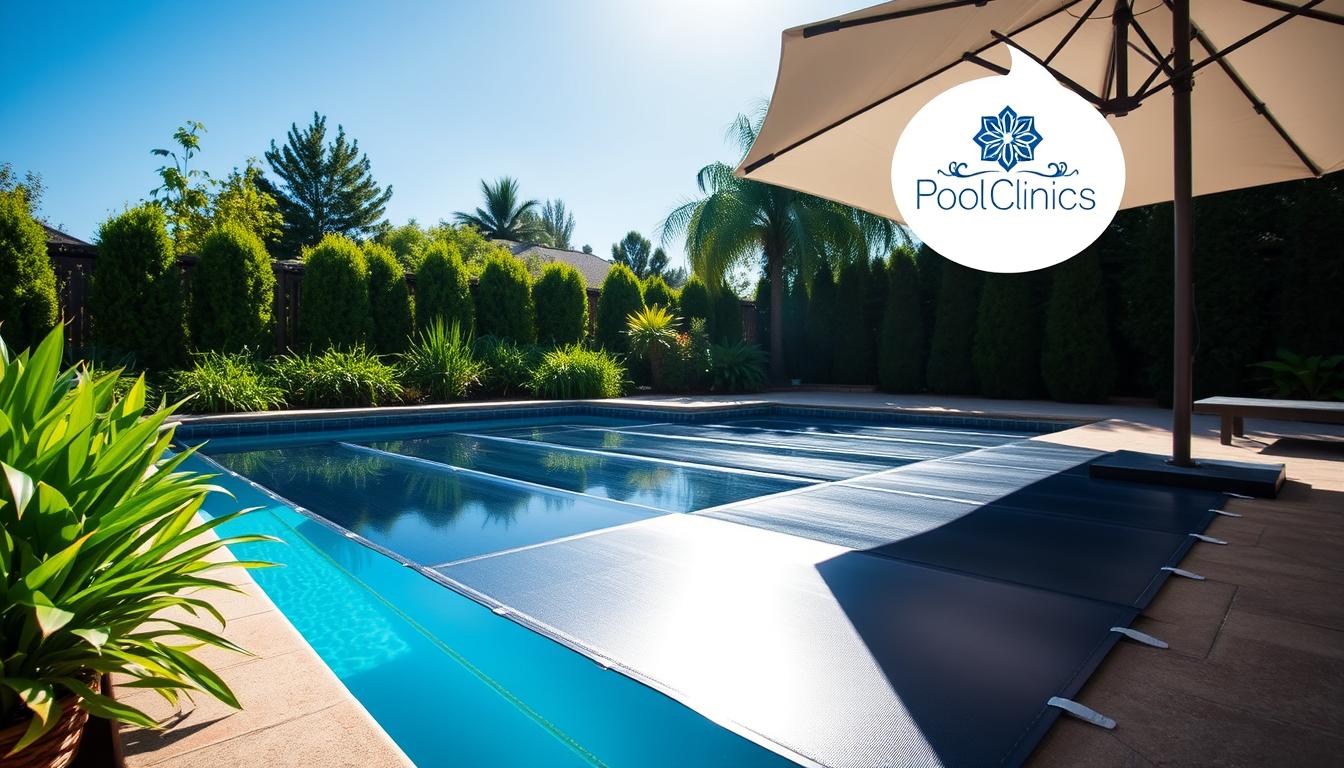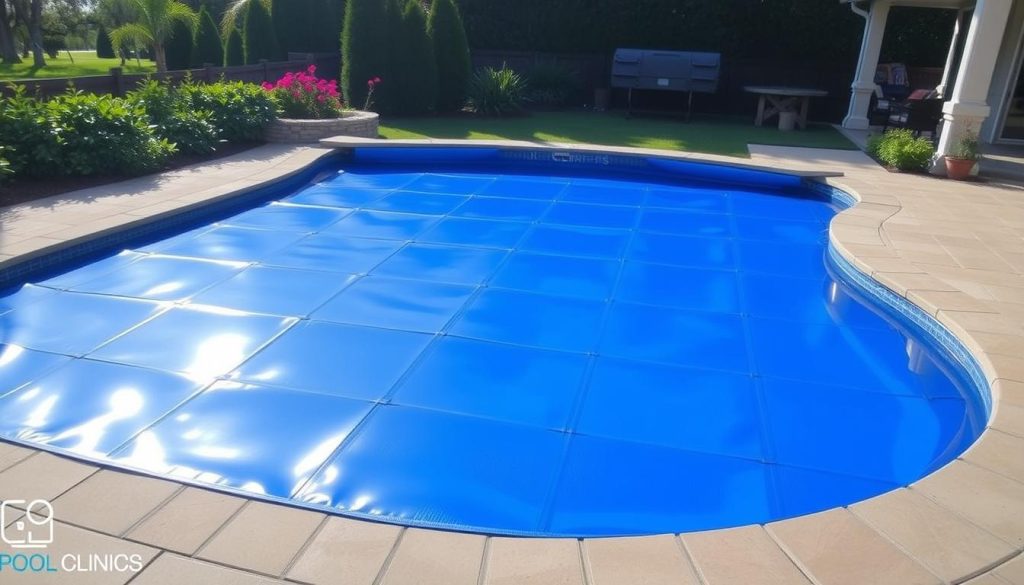
Solar covers are vital for enjoyable, cost-effective pool ownership. They maintain water temperature and reduce evaporation and heating costs. Proper cover orientation is key to maximizing these benefits.
This guide explores solar pool covers and their optimal setup. We’ll discuss heat retention, UV blocking, and differences between winter and summer covers.
You’ll learn which side of your pool solar cover should face up. This knowledge will help you enjoy a warm pool all season long.
Key Takeaways
- Solar pool covers help maintain water temperature and reduce heating costs.
- Proper solar cover positioning is crucial for optimal heat transfer and bubble protection.
- Place the solar cover with bubbles facing down into the water for the best results.
- Different cover thicknesses and materials offer varying levels of heat retention and UV blocking.
- Regular maintenance and correct storage can extend the lifespan of your solar pool cover.
Understanding Solar Pool Covers
Solar pool covers are a smart way to heat your pool. They cut energy costs and water loss. These covers have a bubble wrap design that traps solar energy.
The heat is then transferred into the pool water. This naturally raises the water temperature.

How Solar Pool Covers Work
Solar pool covers let sunlight pass through their clear material. The water absorbs this light. The cover’s design traps heat, keeping it from escaping.
This process keeps pool water warm day and night. It works even when air temperatures drop.
These covers float on the pool’s surface, touching the water. They come in thicknesses from 8 to 16 mil. Thicker covers retain more heat and last longer.
On average, solar pool blankets last 3 to 5 years. Their lifespan depends on quality and care.
Benefits of Using a Solar Pool Cover
- Heat absorption: Solar blankets capture solar energy, naturally increasing water temperature and reducing heating costs.
- Water evaporation reduction: By covering the pool surface, solar covers minimize water evaporation, saving up to 100 liters of water per day.
- Energy savings: Solar pool covers reduce the need for additional heating systems, leading to significant energy savings.
- Chemical efficiency: By reducing evaporation, solar blankets help maintain the effectiveness of pool chemicals, reducing the frequency of chemical additions and saving on maintenance costs.
- Extended swimming season: With the ability to keep water warm, solar covers allow for a more comfortable swimming experience and an extended swimming season, even during cooler months.
| Benefit | Description |
|---|---|
| Water conservation | Reduce water evaporation by up to 95%, saving an estimated $102.20 to $140.89 per year in water costs |
| Energy savings | Minimize the need for additional heating systems, reducing energy consumption and costs |
| Extended swimming season | Maintain warm water temperatures, allowing for comfortable swimming even during cooler months |
Solar pool covers offer many perks for pool owners. They raise water temperature and cut evaporation. Users can save money on energy and upkeep.
Installing Your Solar Pool Cover
A solar pool cover can help you save on heating costs and reduce water evaporation. Proper installation ensures optimal performance and longevity. Measuring, cutting, and placing your cover correctly is crucial.
Using a solar cover roller makes installation and removal more convenient. This simple process can greatly benefit your pool maintenance routine.
Measuring and Cutting Your Solar Cover
Accurately measure your pool’s dimensions before buying a solar cover. A solar pool cover calculator can help determine the right size. Irregular pool shapes may require custom trimming.
Take care when cutting your cover to avoid stretching or distortion. Use sharp scissors or a utility knife for precise cuts. Consider curved angles around obstacles to prevent weak points.
Placing the Solar Cover on the Pool
Your solar cover should cover the entire pool surface for maximum effectiveness. Align the edges with the pool wall for a snug fit. Leave a few inches of excess material folded against the wall.
Ensure the cover floats on the water’s surface. This allows for effective heat transfer and reduced evaporation. Improper positioning may hinder the cover’s function.
Using a Solar Cover Roller or Reel
A solar cover roller makes handling your cover much easier. It allows for quick installation and removal without manual lifting. This saves time and reduces wear and tear on the cover.
| Without Cover Roller | With Cover Roller |
|---|---|
| 10-15 minutes to roll/unroll | 1-2 minutes to roll/unroll |
| Manual lifting required | Easy installation and removal |
| Increased wear and tear | Reduced wear and tear |
| Rocks or bricks needed to secure | Cover stays in place securely |
Solar covers attach easily to rollers using connectors and attachment kits. This ensures secure connection and smooth rolling. Store the cover on the roller when not in use to protect it.
Investing in a solar cover roller or reel can significantly increase the frequency of pool cover use, as it makes the process of covering and uncovering the pool much more convenient and less time-consuming.
Pool Solar Cover: Which Side Up?
Proper installation of a solar pool cover is crucial. Placing the correct side up impacts its heating effectiveness. Let’s explore why the right orientation matters for your pool cover.
Importance of Proper Solar Cover Orientation
Solar pool covers capture sun’s heat and transfer it to the water. The bubble design is key to this process. Correct installation, with bubbles down, ensures optimal heat transfer and retention.
Improper orientation can reduce efficiency and damage the cover. It’s essential to place the cover correctly for best results.
Bubbles Down for Optimal Heat Transfer
The bubble side should always touch the water directly. Bubbles are designed to capture sun’s heat and transfer it to the pool.
When bubbles face down, trapped air heats up from sunlight. This warm air then transfers heat to the water, raising pool temperature.
If bubbles face up, heat won’t transfer efficiently to water. This can cause the cover to overheat and deteriorate quickly.
| Solar Cover Thickness | Potential Temperature Increase |
|---|---|
| 8 mil | 5-10°F |
| 12 mil | 10-15°F |
| 16 mil | 15-18°F |
The table shows how cover thickness affects water temperature. Thicker covers (12 or 16 mil) provide more substantial temperature gains.
However, all covers must have bubbles facing down for optimal heat transfer. This ensures the best performance, regardless of thickness.
Proper orientation maximizes your cover’s efficiency in capturing and transferring heat. This simple step extends your swimming season and maintains comfortable water temperature.
Conclusion
Solar pool covers are a smart choice for pool owners. They save energy and keep your pool comfortable. Proper installation with bubbles facing down maximizes heat transfer and reduces evaporation.
These covers cut energy costs and reduce maintenance needs. They also help maintain chemical balance in your pool. Taking care of your cover is essential for its longevity.
Clean your cover regularly and store it carefully when not in use. Protect it from too much sun exposure. These steps will help your cover last longer.
A quality solar pool cover can make your pool more efficient. It offers comfort, convenience, and cost savings. Embrace solar technology and enjoy your improved pool experience.







